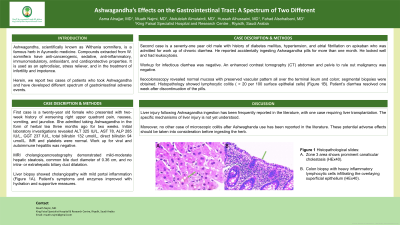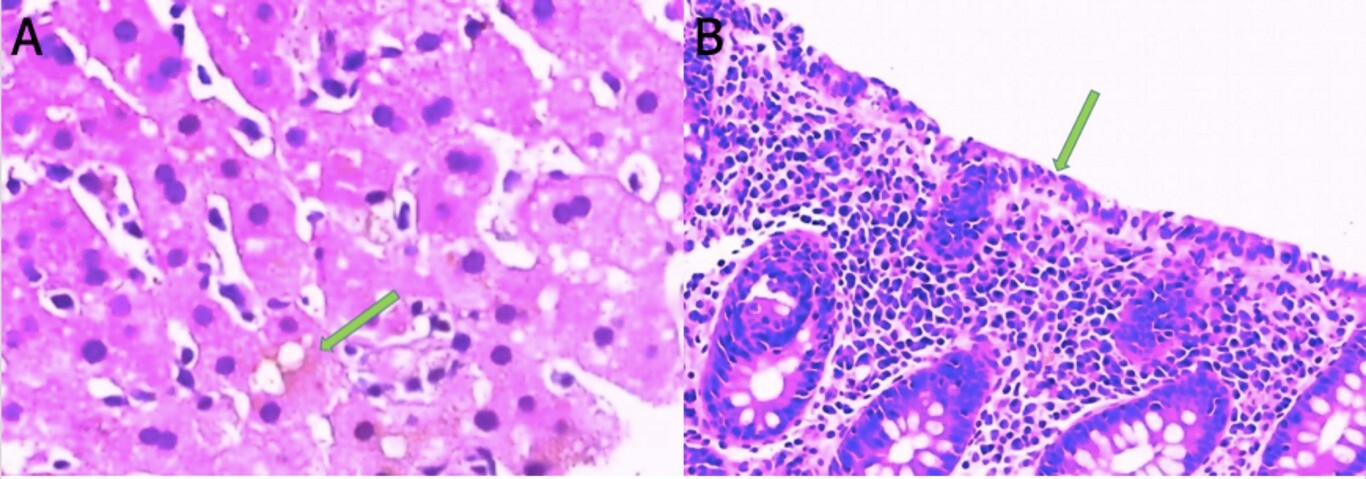Sunday Poster Session
Category: Liver
P1342 - Ashwagandha’s Effects on the Gastrointestinal Tract: A Spectrum of Two Different Presentations
Sunday, October 27, 2024
3:30 PM - 7:00 PM ET
Location: Exhibit Hall E

Has Audio

Muath Najmi, MD
King Faisal Specialist Hospital and Research Centre
Riyadh, Ar Riyad, Saudi Arabia
Presenting Author(s)
Asma Alnajjar, MD, Muath Najmi, MD, Abdulelah Almutairdi, MD, Hussah Alhussaini, MD, Fahad Alsohaibani, MD
King Faisal Specialist Hospital and Research Centre, Riyadh, Ar Riyad, Saudi Arabia
Introduction: Ashwagandha, scientifically known as Withania somnifera, is a famous herb in Ayurvedic medicine. Compounds extracted from W. somnifera have anti-cancerogenic, sedative, anti-inflammatory, immunomodulatory, antioxidant, and cardioprotective properties. It is used as an aphrodisiac, stress reliever, and in the treatment of infertility and impotence. Herein, we report two cases of patients who took ashwagandha and have developed different spectrum of gastrointestinal adverse events.
Case Description/Methods: First case is a twenty-year old female who presented with two-week history of worsening right upper quadrant pain, nausea, vomiting, and jaundice. She admitted taking Ashwagandha in the form of herbal tea for two weeks three months ago. Initial laboratory investigations revealed ALT 325 IU/L, AST 78, ALP 285 IU/L, GGT 237 IU/L, total bilirubin 132 umol/L, direct bilirubin 94 umol/L. INR and platelets were normal. Work up for viral and autoimmune hepatitis was negative. MRI cholangiopancreatography demonstrated mild-moderate hepatic steatosis, common bile duct diameter of 0.36 cm, and no intra- or extrahepatic biliary duct dilatation. Liver biopsy showed cholangiopathy with mild portal inflammation consistent (Figure 1A). Patient’s symptoms and enzymes improved with hydration and supportive measures.
Second case is a seventy-one year old male with history of diabetes mellites, hypertension, and atrial fibrillation on apixaban who was admitted for work up of chronic diarrhea. He reported accidentally ingesting ashwagandha pills for more than one month. He looked well and had leukocytosis. Workup for infectious diarrhea was negative. An enhanced contrast tomography (CT) abdomen and pelvis to rule out malignancy was negative. Ileocolonoscopy revealed normal mucosa with preserved vascular pattern all over the terminal ileum and colon; segmental biopsies were obtained. Histopathology showed lymphocytic colitis ( > 20 per 100 surface epithelial cells) (Figure 1B). Patient’s diarrhea resolved one week after discontinuation of the pills.
Discussion: Liver injury following ashwagandha ingestion has been frequently reported in the literature, with one case requiring liver transplantation. The specific mechanisms of liver injury is not yet understood. Moreover, no other case of microscopic colitis after ashwaghanda use has been reported in the literature. These potential adverse effects should be taken into consideration before ingesting the herb.

Disclosures:
Asma Alnajjar, MD, Muath Najmi, MD, Abdulelah Almutairdi, MD, Hussah Alhussaini, MD, Fahad Alsohaibani, MD. P1342 - Ashwagandha’s Effects on the Gastrointestinal Tract: A Spectrum of Two Different Presentations, ACG 2024 Annual Scientific Meeting Abstracts. Philadelphia, PA: American College of Gastroenterology.
King Faisal Specialist Hospital and Research Centre, Riyadh, Ar Riyad, Saudi Arabia
Introduction: Ashwagandha, scientifically known as Withania somnifera, is a famous herb in Ayurvedic medicine. Compounds extracted from W. somnifera have anti-cancerogenic, sedative, anti-inflammatory, immunomodulatory, antioxidant, and cardioprotective properties. It is used as an aphrodisiac, stress reliever, and in the treatment of infertility and impotence. Herein, we report two cases of patients who took ashwagandha and have developed different spectrum of gastrointestinal adverse events.
Case Description/Methods: First case is a twenty-year old female who presented with two-week history of worsening right upper quadrant pain, nausea, vomiting, and jaundice. She admitted taking Ashwagandha in the form of herbal tea for two weeks three months ago. Initial laboratory investigations revealed ALT 325 IU/L, AST 78, ALP 285 IU/L, GGT 237 IU/L, total bilirubin 132 umol/L, direct bilirubin 94 umol/L. INR and platelets were normal. Work up for viral and autoimmune hepatitis was negative. MRI cholangiopancreatography demonstrated mild-moderate hepatic steatosis, common bile duct diameter of 0.36 cm, and no intra- or extrahepatic biliary duct dilatation. Liver biopsy showed cholangiopathy with mild portal inflammation consistent (Figure 1A). Patient’s symptoms and enzymes improved with hydration and supportive measures.
Second case is a seventy-one year old male with history of diabetes mellites, hypertension, and atrial fibrillation on apixaban who was admitted for work up of chronic diarrhea. He reported accidentally ingesting ashwagandha pills for more than one month. He looked well and had leukocytosis. Workup for infectious diarrhea was negative. An enhanced contrast tomography (CT) abdomen and pelvis to rule out malignancy was negative. Ileocolonoscopy revealed normal mucosa with preserved vascular pattern all over the terminal ileum and colon; segmental biopsies were obtained. Histopathology showed lymphocytic colitis ( > 20 per 100 surface epithelial cells) (Figure 1B). Patient’s diarrhea resolved one week after discontinuation of the pills.
Discussion: Liver injury following ashwagandha ingestion has been frequently reported in the literature, with one case requiring liver transplantation. The specific mechanisms of liver injury is not yet understood. Moreover, no other case of microscopic colitis after ashwaghanda use has been reported in the literature. These potential adverse effects should be taken into consideration before ingesting the herb.

Figure: Figure 1 Histopathological slides: A. Zone 3 area shows prominent canalicular cholestasis (HEx40). B. Colon biopsy with heavy inflammatory lymphocytic cells infiltrating the overlaying superficial epithelium (HEx40).
Disclosures:
Asma Alnajjar indicated no relevant financial relationships.
Muath Najmi indicated no relevant financial relationships.
Abdulelah Almutairdi indicated no relevant financial relationships.
Hussah Alhussaini indicated no relevant financial relationships.
Fahad Alsohaibani indicated no relevant financial relationships.
Asma Alnajjar, MD, Muath Najmi, MD, Abdulelah Almutairdi, MD, Hussah Alhussaini, MD, Fahad Alsohaibani, MD. P1342 - Ashwagandha’s Effects on the Gastrointestinal Tract: A Spectrum of Two Different Presentations, ACG 2024 Annual Scientific Meeting Abstracts. Philadelphia, PA: American College of Gastroenterology.
